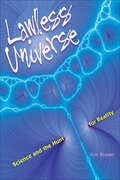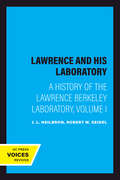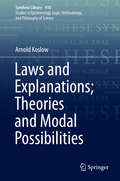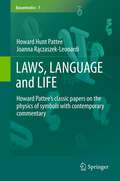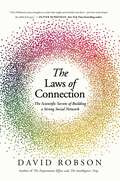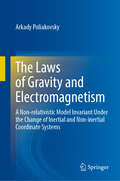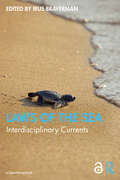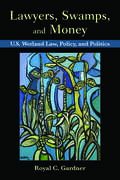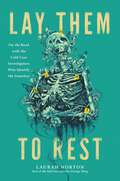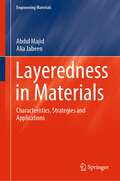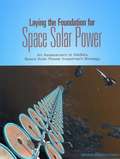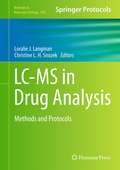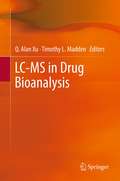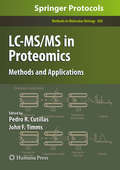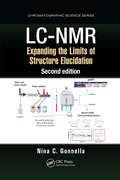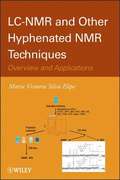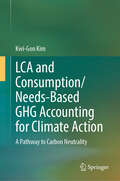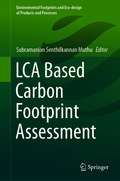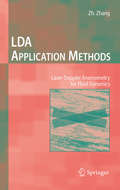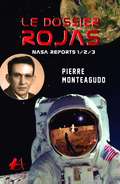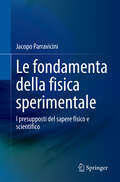- Table View
- List View
Lawless Universe: Science and the Hunt for Reality
by Joe RosenIn this provocative reassessment of science, a physicist questions whether it can ever fully comprehend the entire material universe.There is no question that modern science has radically advanced our understanding of nature, the universe, and even reality itself. But in Lawless Universe, theoretical physicist Joe Rosen takes the scientific method down a peg. In his estimation, people like Stephen Hawking and Richard Dawkins are wrong to declare that science is on the verge of unlocking all the secrets of the universe. Perhaps without realizing it, they have crossed into the realm of metaphysics in an attempt to explain the unexplainable. Rosen considers the separate but entangled domains of science and metaphysics and examines the all-too-often ignored boundary between the objective and the subjective. He asserts that any understanding of the whole universe, if it is to be found at all, must come from nonscientific modes of comprehension and insight.
Lawrence and His Laboratory: A History of the Lawrence Berkeley Laboratory, Volume I (California Studies in the History of Science #5)
by J. L. Heilbron Robert W. SeidelThe Radiation Laboratory in Berkeley, California, was the birthplace of particle accelerators, radioisotopes, and modern big science. This first volume of its history is a saga of physics and finance in the Great Depression, when a new kind of science was born.Here we learn how Ernest Lawrence used local and national technological, economic, and manpower resources to build the cyclotron, which enabled scientists to produce high-voltage particles without high voltages. The cyclotron brought Lawrence forcibly and permanently to the attention of leaders of international physics in Brussels at the Solvay Congress of 1933. Ever since, the Rad Lab has played a prominent part on the world stage.The book tells of the birth of nuclear chemistry and nuclear medicine in the Laboratory, the discoveries of new isotopes and the transuranic elements, the construction of the ultimate cyclotron, Lawrence's Nobel Prize, and the energy, enthusiasm, and enterprise of Laboratory staff. Two more volumes are planned to carry the story through the Second World War, the establishment of the system of national laboratories, and the loss of Berkeley's dominance of high-energy physics.
Laws and Explanations; Theories and Modal Possibilities (Synthese Library #410)
by Arnold KoslowThe book has two parts: In the first, after a review of some seminal classical accounts of laws and explanations, a new account is proposed for distinguishing between laws and accidental generalizations (LAG). Among the new consequences of this proposal it is proved that any explanation of a contingent generalization shows that the generalization is not accidental. The second part involves physical theories, their modality, and their explanatory power. In particular, it is shown that (1) Each theory has a theoretical implication structure associated with it, such that there are new physical modal operators on these structures and also special modal entities that are in these structures. A special subset of the physical modals, the nomic modals are associated with the laws of theories. (2) The familiar idea that theories always explain laws by deduction of them has to be seriously modified in light of the fact that there are a host of physical theories (including for example, Newtonian Classical mechanics, Hamiltonian, and Lagrangian theory, and probability theory) that we believe are schematic (they do not have any truth value). Nevertheless, we think that there is a kind of non-deductive explanation and generality that they achieve by subsumtion under a schema.
LAWS, LANGUAGE and LIFE
by Howard Hunt Pattee Joanna Rączaszek-LeonardiHoward Pattee is a physicist who for many years has taken his own path in studying the physics of symbols, which is now a foundation for biosemiotics. By extending von Neumann's logical requirements for self-replication, to the physical requirements of symbolic instruction at the molecular level, he concludes that a form of quantum measurement is necessary for life. He explains why all non-dynamic symbolic and informational controls act as special (allosteric) constraints on dynamical systems. Pattee also points out that symbols do not exist in isolation but in coordinated symbol systems we call languages. Such insights turn out to be necessary to situate biosemiotics as an objective scientific endeavor. By proposing a way to relate quiescent symbolic constraints to dynamics, Pattee's work builds a bridge between physical, biological, and psychological models that are based on dynamical systems theory. Pattee's work awakes new interest in cognitive scientists, where his recognition of the necessary separation--the epistemic cut--between the subject and object provides a basis for a complementary third way of relating the purely symbolic, computational models of cognition and the purely dynamic, non-representational models. This selection of Pattee's papers also addresses several other fields, including hierarchy theory, artificial life, self-organization, complexity theory, and the complementary epistemologies of the physical and biological sciences.
The Laws of Connection: The Scientific Secrets of Building a Strong Social Network
by David RobsonThis groundbreaking study reveals how social connections are far more important than we thought, showing us the steps we can take to build better relationships and improve our lives.Social connection is as essential for our health and happiness as a balanced diet and regular exercise. It reduces our risk of stroke, heart disease, and Alzheimer&’s. It enhances our creativity and adds years to our life span. Yet many of us struggle to form strong and meaningful bonds—and the problem lies not with our personalities but with a series of cognitive biases that stop us from fulfilling our social potential. In The Laws of Connection, award-winning science writer David Robson describes the psychological barriers that lead us to keep others at a distance and offers evidence-based strategies to overcome them. Drawing on philosophy, neuroscience, and cutting-edge psychology, Robson introduces readers to new concepts such as the liking gap, the novelty penalty, the fast-friendship procedure, the beautiful mess effect, and the Japanese art of amae. Whether we are shy or confident, introvert or extrovert, we can all build deeper relationships. The Laws of Connection shows us how.
The Laws of Gravity and Electromagnetism: A Non-relativistic Model Invariant Under the Change of Inertial and Non-inertial Coordinate Systems
by Arkady PoliakovskyIn this book the author derives, under the classical non-relativistic consideration of the space-time, general forms of the most common physical laws invariant under the changes of inertial or non-inertial coordinate systems, both in the classical and the quantum regime. Important examples of such invariant physical laws are the Maxwell Equations, Newtonian gravity as well as several more complicated models of gravity and many other physical laws including many of the laws of quantum mechanics, thermodynamics and statistical physics, continuum mechanics, and optics. Moreover, several basic laws of relativistic physics, both in the classical and quantum regimes can be still formulated invariantly under the non-relativistic consideration of space-time. These include the classical relativistic Second Law of Newton and the quantum Dirac and Klein--Gordon equations for relativistic particles, including their interaction with the external gravitational field. In particular, we introduce the Hamiltonian formulation of the Dirac equation, and moreover, were able to formulate the Dirac equation for multiple particles, similarly to what was done for the Schroedinger equation of the non-relativistic quantum mechanics. One of the goals of this work is to provide a self-contained and simple mathematical formulation of the most general physical laws in a manner understandable to the reader familiar only with basic calculus, classical mechanics and basic elements of non-relativistic quantum mechanics.
The Laws of Robots: Crimes, Contracts, and Torts
by Ugo PagalloThis book explores how the design, construction, and use of robotics technology may affect today's legal systems and, more particularly, matters of responsibility and agency in criminal law, contractual obligations, and torts. By distinguishing between the behaviour of robots as tools of human interaction, and robots as proper agents in the legal arena, jurists will have to address a new generation of "hard cases." General disagreement may concern immunity in criminal law (e.g., the employment of robot soldiers in battle), personal accountability for certain robots in contracts (e.g., robo-traders), much as clauses of strict liability and negligence-based responsibility in extra-contractual obligations (e.g., service robots in tort law). Since robots are here to stay, the aim of the law should be to wisely govern our mutual relationships.
Laws of the Land: Fengshui and the State in Qing Dynasty China
by Tristan G. BrownA groundbreaking history of fengshui’s roles in public life and law during China’s last imperial dynastyToday the term fengshui, which literally means “wind and water,” is recognized around the world. Yet few know exactly what it means, let alone its fascinating history. In Laws of the Land, Tristan Brown tells the story of the important roles—especially legal ones—played by fengshui in Chinese society during China’s last imperial dynasty, the Manchu Qing (1644–1912).Employing archives from Mainland China and Taiwan that have only recently become available, this is the first book to document fengshui’s invocations in Chinese law during the Qing dynasty. Facing a growing population, dwindling natural resources, and an overburdened rural government, judicial administrators across China grappled with disputes and petitions about fengshui in their efforts to sustain forestry, farming, mining, and city planning. Laws of the Land offers a radically new interpretation of these legal arrangements: they worked. An intelligent, considered, and sustained engagement with fengshui on the ground helped the imperial state keep the peace and maintain its legitimacy, especially during the increasingly turbulent decades of the nineteenth century. As the century came to an end, contentious debates over industrialization swept across the bureaucracy, with fengshui invoked by officials and scholars opposed to the establishment of railways, telegraphs, and foreign-owned mines.Demonstrating that the only way to understand those debates and their profound stakes is to grasp fengshui’s longstanding roles in Chinese public life, Laws of the Land rethinks key issues in the history of Chinese law, politics, science, religion, and economics.
Laws of the Sea: Interdisciplinary Currents
by Irus BravermanLaws of the Sea assembles scholars from law, geography, anthropology, and environmental humanities to consider the possibilities of a critical ocean approach in legal studies. Unlike the United Nations’ monumental Convention on the Law of the Sea, which imagines one comprehensive constitutional framework for governing the ocean, Laws of the Sea approaches oceanic law in plural and dynamic ways. Critically engaging contemporary concerns about the fate of the ocean, the collection’s twelve chapters range from hydrothermal vents through the continental shelf and marine genetic resources to coastal communities in France, Sweden, Florida, and Indonesia. Documenting the longstanding binary of land and sea, the chapters pose a fundamental challenge to European law’s “terracentrism” and its pervasive influence on juridical modes of knowing and making the world. Together, the chapters ask: is contemporary Eurocentric law—and international law in particular—capable of moving away from its capitalist and colonial legacies, established through myriad oceanic abstractions and classifications, toward more amphibious legalities? Laws of the Sea will appeal to legal scholars, geographers, anthropologists, cultural and political theorists, as well as scholars in the environmental humanities, political ecology, ocean studies, and animal studies.
Laws, Theories, and Patterns in Ecology
by Walter K. DoddsIntroductory material describes how the practice of science in general, and ecology specifically, yields theories and laws. Dodds also discusses why such ideas are only useful if they have predictive ability, and delineates the scope of these generalizations and the constraints that limit their application.
Lawyers, Swamps, and Money: U.S. Wetland Law, Policy, and Politics
by Royal C GardnerLawyers, Swamps, and Money is an accessible, engaging guide to the complex set of laws governing America's wetlands. After explaining the importance of these critical natural areas, the book examines the evolution of federal law, principally the Clean Water Act, designed to protect them. Readers will first learn the basics of administrative law: how agencies receive and exercise their authority, how they actually make laws, and how stakeholders can influence their behavior through the Executive Branch, Congress, the courts, and the media. These core concepts provide a base of knowledge for successive discussions of: the geographic scope and activities covered by the Clean Water Act the curious relationship between the U.S. Army Corps of Engineers and the Environmental Protection Agency the goal of no net loss of wetlands the role of entrepreneurial wetland mitigation banking the tension between wetland mitigation bankers and in-lieu fee mitigation programs wetland regulation and private property rights. The book concludes with insightful policy recommendations to make wetlands law less ambiguous and more effective. A prominent legal scholar and wetlands expert, professor Royal C. Gardner has a rare knack for describing landmark cases and key statutes with uncommon clarity and even humor. Students of environmental law and policy and natural resource professionals will gain the thorough understanding of administrative law needed to navigate wetlands policy-and they may even enjoy it.
Lay Them to Rest: On the Road with the Cold Case Investigators Who Identify the Nameless
by Laurah NortonTake a fascinating deep dive into the dark world of forensic science as experts team up to solve the identity of an unknown woman by exploring the rapidly evolving techniques being used to break the most notorious cold cases. Fans of true crime shows like CSI, NCIS, Criminal Minds, and Law and Order know that when it comes to &“getting the bad guy&” behind bars, your best chance of success boils down to the strength of your evidence—and the forensic science used to obtain it. Beyond the silver screen, forensic science has been used for decades to help solve even the most tough-to-crack cases. In 2018, the accused Golden State Killer, Joseph DeAngelo, was finally apprehended after a decades-long investigation thanks to a very recent technique called forensic genealogy, which has since led to the closure of hundreds of cold cases, bringing long-awaited justice to victims and families alike. But when it comes to solving these incredibly difficult cases, forensic genealogy is just the tip of the iceberg—and many readers have no idea just how far down that iceberg goes. For Laurah Norton, forensic science was always more of a passion than anything else. But after learning about a mishandled 1990s cold case involving missing twins, she was spurred to action, eventually creating a massively popular podcast and building a platform that helped bring widespread attention and resources to the case. LAY THEM TO REST builds on Laurah&’s fascination with these investigations, introducing readers to the history and evolution of forensic science, from the death masks used in Ancient Rome to the 3-D facial reconstruction technology used today. Incorporating the stories of real-life John & Jane Does from around the world, Laurah also examines how changing identification methods have helped solve the most iconic cold cases. Along the way readers will also get to see Laurah solve a case in real time with forensic anthropologist Dr. Amy Michael, as they try to determine the identity of &“Ina&” Jane Doe, a woman whose head was found in a brush in an Illinois park in 1993. More than just a chronicle of the history of forensics, LAY THEM TO REST is also a celebration of the growing field of experts, forensic artists, and anthropologists (many of whom Laurah talks to in the book), who work tirelessly to bring closure to these unsolved cases. And of course, this book asks why some cases go unsolved, highlighting the &“missing missing,&” the sex workers, undocumented, the cases that so desperately need our attention, but so rarely get it. Engrossing, informative, heartbreaking, and hopeful, LAY THEM TO REST is a deep dive into the world of forensic science, showing readers how far we&’ve come in cracking cases and catching killers, and illuminating just how far we have yet to go.
Layeredness in Materials: Characteristics, Strategies and Applications (Engineering Materials)
by Abdul Majid Alia JabeenThis book provides information on the characteristics, strategies and applications of layered materials. It sheds light on layerdness-dependent properties of Van der Waals solids for potential applications. The properties of various layered materials prepared using different experimental strategies are described. Further, the first-principles calculations are given to devise a strategy to investigate layeredness in materials. The structural, thermal, mechanical, lattice vibronic, electronic, optical and carrier transport characteristics of the layered materials are elaborated in detail. This book provides an updated source of information on layered materials for students, researchers, and professionals.
Laying the Foundation for Space Solar Power: An Assessment of NASA's Space Solar Power Investment Strategy
by Committee for the Assessment of NASA's Space Solar Power Investment StrategyInformation on Laying the Foundation for Space Solar Power
Lazare and Sadi Carnot
by Charles C. Gillispie Raffaele PisanoLazare Carnot was the unique example in the history of science of someone who inadvertently owed the scientific recognition he eventually achieved to earlier political prominence. He and his son Sadi produced work that derived from their training as engineering and went largely unnoticed by physicists for a generation or more, even though their respective work introduced concepts that proved fundamental when taken up later by other hands. There was, moreover, a filial as well as substantive relation between the work of father and son. Sadi applied to the functioning of heat engines the analysis that his father had developed in his study of the operation of ordinary machines. Specifically, Sadi's idea of a reversible process originated in the use his father made of geometric motions in the analysis of machines in general. This unique book shows how the two Carnots influenced each other in their work in the fields of mechanics and thermodynamics, and how future generations of scientists have further benefited from their work.
LC-MS in Drug Analysis
by Loralie J. Langman Christine L. SnozekLiquid-Chromatography-Mass-Spectrometry procedures have been shown to be successful when applied to drug development and analysis. LC-MS in Drug Analysis: Methods and Protocols provides detailed LC-MS/MS procedures for the analysis of several compounds of clinical significance. The first chapters provide the reader with an overview of mass spectroscopy, its place in clinical practice, its application of MS to TDM and toxicology, and the merits of LC-MS(/MS) and new sample preparation techniques. The following chapters discuss different approaches to screening for drugs of abuse and for general unknowns, as well as targeted measurement of specific analytes or classes of analytes including abused drugs, toxic compounds, and therapeutic agents. Written in the successful Methods in Molecular BiologyTM series format, chapters include introductions to their respective topics, lists of the necessary materials and reagents, step-by-step, readily reproducible protocols, and notes on troubleshooting and avoiding known pitfalls. Authoritative and easily accessible, LC-MS in Drug Analysis: Methods and Protocols seeks to serve both professionals and novices with its well-honed methodologies.
LC-MS in Drug Bioanalysis
by Q. Alan Xu Timothy L. MaddenClinical pharmacology plays an important role in today's medicine. Due to the high sensitivity, selectivity, and affordability of a mass spectrometer (MS), the high performance liquid chromatography - mass spectrometry (LC-MS) analytical technique is widely used in the determination of drugs in human biological matrixes for clinical pharmacology. Specifically, LC-MS is used to analyze: anticancer drugs antidementia drugs antidepressant drugs antiepileptic drugs antifundal drug antimicrobial drugs antipsychotic drugs antiretroviral drugs anxiolytic/hypnotic drugs cardiac drugs drugs for addiction immunosuppressant drugs mood stabilizer drugs This book will primarily cover the various methods of validation for LC-MS techniques and applications used in modern clinical pharmacology.
LC-MS/MS in Proteomics
by John F. Timms Pedro R. CutillasWith the development of new quantitative strategies and powerful bioinformatics tools to cope with the analysis of the large amounts of data generated in proteomics experiments, liquid chromatography with tandem mass spectrometry (LC-MS/MS) is making possible the analysis of proteins on a global scale, meaning that proteomics can now start competing with cDNA microarrays for the analysis of whole genomes. In LC-MS/MS in Proteomics: Methods and Applications, experts in the field provide protocols and up-to-date reviews of the applications of LC-MS/MS, with a particular focus on MS-based methods of protein and peptide quantification and the analysis of post-translational modifications. Beginning with overviews of the use of LC-M/MS in protein analysis, the book continues with topics such as protocols for the analysis of post-translational modifications, with particular focus on phosphorylation and glycosylation, popular techniques for quantitative proteomics, such as multiple reaction monitoring, metabolic labelling, and chemical tagging, biomarker discovery in biological fluids, as well as novel applications of LC-MS/MS. Written in the highly successful Methods in Molecular BiologyTM series format, chapters include introductions to their respective subjects, lists of necessary materials and reagents, step-by-step, readily reproducible laboratory protocols, and notes on troubleshooting and avoiding known pitfalls. Comprehensive and cutting-edge, LC-MS/MS in Proteomics: Methods and Applications presents the techniques and concepts necessary in order to aid proteomic practitioners in the application of LC-MS/MS to essentially any biological problem.
LC-NMR: Expanding the Limits of Structure Elucidation (Chromatographic Science Series)
by Nina C. GonnellaThe isolation and structural characterization of substances present at very low concentrations, as is necessary to satisfy regulatory requirements for pharmaceutical drug degradants and impurities, can present scientific challenges. The coupling of HPLC with NMR spectroscopy has been at the forefront of cutting-edge technologies to address these issues. LC-NMR: Expanding the Limits of Structure Elucidation presents a comprehensive overview of key concepts in HPLC and NMR that are required to achieve definitive structure elucidation with very low levels of analytes. Because skill sets from both of these highly established disciplines are involved in LC-NMR, the author provides introductory background to facilitate readers’ proficiency in both areas, including an entire chapter on NMR theory. The much-anticipated second edition provides guidance in setting up LC-NMR systems, discussion of LC methods that are compatible with NMR, and an update on recent hardware and software advances for system performance, such as improvements in magnet design, probe technology, and solvent suppression techniques that enable unprecedented mass sensitivity in NMR. This edition features methods to quantify concentration and assess purity of isolated metabolites on the micro scale and incorporates computational approaches to accelerate the structure elucidation process. The author also includes implementation and application of qNMR and automated and practical use of computational chemistry combined with QM and DFT to predict highly accurate NMR chemical shifts. The text focuses on current developments in chromatographic-NMR integration, with particular emphasis on utility in the pharmaceutical industry. Applications include trace analysis, analysis of mixtures, and structural characterization of degradation products, impurities, metabolites, peptides, and more. The text discusses novel uses and emerging technologies that challenge detection limits as well future directions for this important technique. This book is a practical primary resource for NMR structure determination—including theory and application—that guides the reader through the steps required for isolation and NMR structure elucidation on the micro scale.
LC-NMR and Other Hyphenated NMR Techniques
by Maria V. Silva ElipeThis practical guide provides a basic overview of the pros and cons of NMR spectroscopy as both a hyphenated and non-hyphenated technique. The book begins with a description of basic NMR concepts for the structural elucidation of organic compounds and then details the historical development of NMR and hyphenated NMR in the structural elucidation world, followed by applications of hyphenated NMR as LC-NMR and LC-MS-NMR in industry and academia. It also contains updated information on the latest advancements and applications of LC-NMR in such areas as degradation products, drug metabolism, food analysis, and drug discovery. An essential resource for scientists in industry and academia who work in the areas of organic chemistry, medicinal chemistry, process chemistry, and analytical chemistry.
LCA and Consumption/Needs-Based GHG Accounting for Climate Action: A Pathway to Carbon Neutrality
by Kwi-Gon KimThis book reveals causes of the GHG emission accounting practice failure over the last several decades, describes evolution of new tenets of the accounting and remaining tasks, and suggests a new comprehensive integrated accounting in the form of protocol. The latest Intergovernmental Panel on Climate Change (IPCC) assessment report calls for net zero CO2 emissions by 2050 to limit warming to 1.5 degree C. As a result, many countries, cities, and industries are putting forward their greenhouse gas (GHG) emission reduction actions and commitments. But can the countries, cities, and industries meet these ambitious decarbonization goals without a reliable GHG inventory? This book tries to answer this question. It has been argued that there is a need to include LCA and consumption/needs-based GHG emissions as a complimentary indicator to the current approach of production-based GHG accounting emissions. As a shifting of the focus of accounting system after the Paris Agreement, consumption/needs-based approach is newly focused on a more broader accounting approach for NDCs and LDCs with a vision of all of society approach. Traditional national inventory approach to GHG emission accounting has been severely criticized as being too production process-oriented, sector-based approach, less transparent, a lack of public participation, no considerations for human needs and human factors.
LCA Based Carbon Footprint Assessment (Environmental Footprints and Eco-design of Products and Processes)
by Subramanian Senthilkannan MuthuThis book discusses the concepts, methods and case studies pertaining to Life Cycle Assessment (LCA) based Carbon Footprint Assessment. It covers chapters on Carbon Footprint Assessment with LCA methodology & case studies on carbon footprint calculation following the LCA approach on power plants in India, Impacts of Vehicle Incidents On CO2 Emissions and school buildings in India.
LDA Application Methods
by Zhengji ZhangThis technical book considers the application side of LDA techniques. Starting from the basic theories that are crucial for each LDA user, the main subject of the book is focused on diverse application methods. In details, it deals with universal methodical techniques that have been mostly developed in the last 15 years. The book thus gives for the first time an application reference for LDA users in improving the optical conditions and enhancing the measurement accuracies. It also provides the guidelines for simplifying the measurements and correcting measurement errors as well as for clarifying the application limits and extending the application areas of LDA techniques. Beside the treatments of some traditional optical and flow mechanical features influencing the measurement accuracies, the book shows a broad spectrum of LDA application methods in the manner of measuring the flow turbulence, resolving the secondary flow structures, and quantifying the optical aberrations at measurements of internal flows etc.. Thus, it also supports the further developments of both the hard- and software of LDA instrumentations.
Le Dossier Rojas
by Pierre Monteagudo Luc WynDescription du livre: Mystères et secrets sont découverts depuis de 5 décennies dans une histoire passionnante qui révèle le complot pour masquer les inventions et les découvertes du docteur Rojas, un scientifique élémentaire pour le débarquement de l’homme sur la lune. Au milieu de la « Guerre Froide », en travaillant pour le NASA, le docteur Rojas s'est réuni avec un président, voyageait á l’ancienne Union Soviétique, prenait la décision fatidique de se rendre á un entrevue á Washington D.C. y depuis, qu'est-ce qui se passait? Les entités impliquées disent que ne savent rien de lui, mais la vérité est cette histoire basée sur la réalité. Quand se rapproche le 50ième anniversaire du premier débarquement d’une équipe sur la lune, nous nous rencontrons avec ce livre fascinant, qui consiste de deux parties. Dans la première, on présente un hommage à la mémoire posthume de l’astrophysicien Héctor R. Rojas, qui pouvait voyager à la lune dans des vols secrets du NASA. Dans la deuxième partie, l’auteur donne ses pensées de toute une vie concernant le phénomène OVNI. Sans doute, il s'agit d’une histoire passionnante écrite dans une langue simple et directe.
Le fondamenta della fisica sperimentale: I presupposti del sapere fisico e scientifico
by Jacopo ParraviciniQuesto libro ha lo scopo di fornire un’ampia riflessione sui principi generali della fisica e gli elementi fondanti della conoscenza scientifica nella loro unitarietà. Sfruttando largamente il pensiero di molti tra i più grandi scienziati, esso offre una chiara comprensione dei fondamenti della fisica e del suo metodo sperimentale, ponendo in risalto le correlazioni tra i principali eterogenei elementi che vi stanno alla base. Si ricorda come le scienze sperimentali non siano statiche ma, al contrario, soggette a continui studi e ripensamenti. Nell'affrontare la mancanza di lezioni o trattazioni sistematiche sulla natura del metodo scientifico nei tradizionali corsi universitari tecnico-scientifici, l'autore si addentra così nello studio di ciò che sta alla base della scienza in generale, e della fisica in particolare. Sono trattati temi quali la relazione tra fenomeni naturali e il linguaggio matematico, mettendo in risalto i principali snodi dello sviluppo concettuale nella scienza. Inoltre l’autore discute l’importanza della “pratica scientifica” sottolineandone il ruolo nell’avanzamento della conoscenza scientifica, e il modo con cui essa contribuisce alla fisica nel suo complesso. Il libro è suddiviso in tre parti, ciascuna delle quali copre differenti aspetti della fisica e dei suoi fondamenti: la prima parte riguarda le radici fenomenologiche e gli strumenti basilari della disciplina; la seconda si concentra sulla struttura della conoscenza scientifica; la terza tratta i metodi pratici dell’indagine scientifica. Il libro rimane accessibile per qualsiasi studente di discipline tecnico-scientifiche, poiché un non fisico sarà agevolmente in grado di trovare facilmente in libri di testo di natura introduttiva spiegazioni di quei concetti fondamentali dati per assodati.
